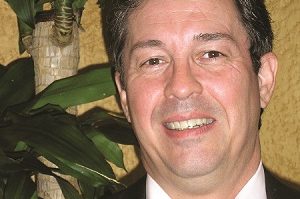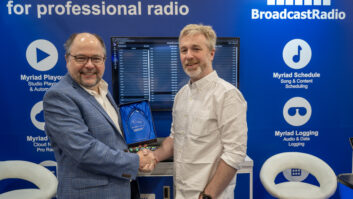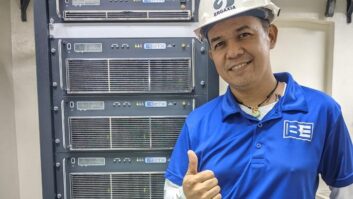
Tim Bealor When many of us think “Broadcast Electronics,” there’s a reflexive association with the name Tim Bealor.
Tim has played multiple roles within that organization for more than four decades, starting as a bench tech and rising to the position of president and CEO.
For many of us in the business, Bealor has been the patient voice on the other end of the phone when we needed help in troubleshooting a problem, the fellow who greeted us at the BE NAB Show booth or perhaps the person who advised us on the best way to invest our engineering budgets when it was time for a station upgrade.
With his deep knowledge of both RF and audio, Bealor has been a “go-to” individual at BE for more years than many of us have been employed in broadcasting. However, the torch is being passed; after more than 40 years of service to the engineering community, Bealor has made the decision to transition into the next phase of his life.
He worked his last day at BE on Dec. 21, capping a career that began when he answered a newspaper ad in the fall of 1975.
ANCHORS AWEIGH
“I’d been in the military for six years, joining the Navy in 1969,” said Bealor. “I’d gotten electronics training in the Navy’s ‘A’ schools and had worked in navigation and ground equipment related to navigation for airplanes. When the time came to end my career with the service, I had some friends in the Washington, D.C., area and they called me and said there’s a full-page ad for technicians in the Sunday Washington Post, so I went there to see what might be available.”
Bealor, now 66, recalled that job opportunities in the electronics field during the post-Vietnam War era were fairly plentiful, especially if you had been in the service.

Tim Bealor provides advice at a trade show early in his career. “There was a lot of demand for veterans, and I had a security clearance too,” said Bealor. “I hadn’t been there long before I had five interviews lined up and out of those came three job offers. One of them was with Broadcast Electronics, which was then located in Silver Spring, Md. There was something about this one that appealed to me and this was the job I took.”
Did he work in radio before joining the Navy — possibly in high school or college, as so many young people electing to follow a broadcasting career path have done?
“Actually, I’d planned to get a degree in agricultural engineering,” said Bealor. “I was sort of raised as a ‘farm kid,’ so this seemed like a natural choice.” However, after a couple of years at Purdue University, he received a Selective Service reclassification that ended his student deferment and sent him to a U.S. Navy recruiting office.
AUDIO CARTS
Broadcast Electronics was a fairly new player in the radio equipment arena when Bealor went to work there.
“The business had been started in 1959 by a couple of engineers who worked at WWDC in Silver Spring. The operation was actually only a short distance from the station. These two individuals more or less invented the audio cart machine.
“When I first walked through the door, they had moved into companders and processors, and were selling Marti RF products with the BE brand. The cart machine had evolved too. They were building a 10-deck version by that time.”

Broadcast Electronics’ original facility in Silver Spring, Md. Bealor’s first assignment upon joining the company was in testing cart machines, and during his early career, was involved in making several advancements in the endless loop recording and playback technology.
“These involved changes in the solenoid mechanism, head mounting and better signal-to-noise performance,” reflected Bealor. “But I can’t really take credit for any of the specific improvements.”
Broadcast Electronics began its transition into the role of a major player in the broadcast equipment supply chain after a 1977 relocation from its suburban Washington home to its present address in Quincy, Ill.
RELOCATING TO ILLINOIS
A former associate of Bealor’s at BE, Geoff Mendenhall, recalled the relocation.
“Actually the plan had been to move to St. Louis, but the deal for a building there fell through,” said Mendenhall. “Larry Cervon, who was the company’s president then, had already committed to moving the company, and I think he wanted to be close to Quincy anyway so that he could get some talent from Harris. That’s how the company wound up in Quincy.”
Bealor also remembers the move as marking the beginning of an expansion from just audio products.
“Broadcast Electronics moved to Quincy with the idea of making an FM transmitter,” said Bealor. “That’s what took us from being a company that built just audio consoles and cart machines. Jim Aurand and Hans Bott designed the first transmitter products. These incorporated a folded half-wave cavity, which eliminated sliding contacts and blocking capacitors. That’s what made the difference in the product. We still produce that basic design today.”
Bealor noted that BE’s first FM exciter products were also among the company’s most successful.

One of Broadcast Electronics’ early products in the world of RF was the FX50 FM exciter. “Those were the FX30 and the FX50; we sold hundreds and hundreds of these,” he said. “They sold so well due to their audio performance. They really became part of the audio processing chain. Engineers and program directors would buy them because the sonic performance was markedly better than anything they’d used before.”
During Bealor’s career, Broadcast Electronics continued to expand its product range, also producing audio consoles, turntables, AM and FM transmitters, FM exciters, newsroom management tools, STLs, RPUs, RDS encoders, HD Radio signal generators and even a pioneering automation system, the AudioVault. The company today considers itself the largest U.S.-based manufacturer that makes nothing but radio broadcast equipment.
“All in all, we probably created more than 100 — probably nearer 200 — products,” he said.
BE eventually retired from manufacturing its seminal product, the audio cart machine; but this was more of an evolutionary process, and Bealor couldn’t be sure exactly when the last machine rolled off the production line.
“We didn’t stop making cart machines until people started using PC-based audio playback systems. This was well into the mid- or late-1980s.”
He noted that while the cart machine was convenient and operator-friendly, it wasn’t really the best way to record and play back audio.
“They had a pretty long run; probably longer than they should have. Cartridge machines were a pretty complicated electromechanical device, but they weren’t really a great sonic quality product. There were a lot of tracks on that little narrow tape and the flutter was bad. Putting audio on a hard drive made a lot more sense.”

Broadcast Electronics was running this ad the year that Bealor joined the company.BE OUTLOOK
About the company’s competitive position today, Bealor told Radio World, “BE is once again on solid ground as a company, with some exciting new products being introduced. We most definitely have been a ‘quieter player’ in the recent past for several reasons; and with the industry in general in what appears to be a slow time, it could take a little longer for BE to get back to full strength. Having said that, we continue to be very strong in certain markets, and have had some nice wins in recent months. Our ownership has been strong through this period, but our past leadership caused us to take our eye off the ball to some degree and it cost us in the technology arena.
“I think that the marketplace will be pleased with what they see in the near future.”
Longtime BE employee Tom Beck now becomes president/CEO, having risen through the sales and sales support side of the organization. “Tom has done a great job for the company for many years,” Bealor said. “I was completely at ease leaving the reins in his hands.”
The company today is owned by Denver-based investment group First City Crestone.
CHANGES IN THE BUSINESS
When asked about changes he’d observed during his career in the radio broadcasting industry, Bealor was quick to mention digital modulation.
“One of the things that I’m most proud to have been involved in is HD Radio,” he said. “No matter how you feel about it, it’s been a big influence on radio in the U.S. and other parts of the world. I was instrumental in getting transmitter manufacturers involved in the initial HD push in the early 2000s. This has been a big push for everybody and there’s no denying that this has also been one of the major issues in radio over the last decade.”
On AM’s future, Bealor’s thoughts are that “there will always be a place for AM radio; there’s nothing else they can do with that frequency band, as there’s just not enough bandwidth for anything else. I do think that, at some point, there will be some kind of digital format adopted for AM in the U.S. — DRM or some other all-digital format. At some point, we will have to work out some sort of system for taking it digital. I believe that all-digital HD may be a viable product for AM broadcasters; we’ve found that ‘standard’ [hybrid] AM HD has not been a viable product.”
What about the programming of AM stations now on the air? “It’s become a homogenized product … Shame on us as radio broadcasters for not providing unique programming.”
Back when the company moved from Maryland, 27 employees along. “Out of those 27, I was one of the few who stayed with the company,” he said. “I’m now the last of that group.”
Bealor was emphatic that he wouldn’t have changed his career path if he had it to do all over again.
“Staying 40 years with one company is almost unheard of anymore,” said Bealor. “I’ve enjoyed it all the way from the test bench where I started to sitting in the corner office, and all the places in between. It’s all been challenging and fun at the same time.
“The industry has really been a joy,” said Bealor. “We’re kind of a closed shop. If you spend any time on the road and out in the industry, you get to know a lot of really nice people — the technical people, the manufacturing people, the advertising guys, station engineers, group chiefs. It’s been really great.
“It’s given me the opportunity to feel like I’m part of something rather than just a programmer sitting in an office or a salesman selling to one small segment of a huge industry. I’ve traveled all over the world and have gotten to meet people who do the same thing and provide service to them.”

The present-day Broadcast Electronics facility in Quincy, Ill.PERSONAL PLANS
For 34 years Bealor has resided in Mendon, Ill., population about 750. It is approximately 12 miles north of Quincy. He’s still there and has no plans to relocate now that his tenure at BE has come to an end, noting that his post-retirement interests aren’t specific to one locale or another.
“I’ve always participated in a lot of sports,” said Bealor. “I like to fish and hunt, and have taken up golf in the last few months. I do a lot of reading, and have two sons and four grandsons and they take up quite a bit of my time.”
Older motor vehicles are also something of a passion with Bealor. He has completely restored a 1971 Triumph TR-6 and a 1946 Chevrolet farm truck that had been rescued from years of disuse in a barn.
“I like to mess around with audio too. I have a pretty extensive collection of tapes and vinyl records, along with some vintage Fisher amps and a Revox 10-inch reel-to-reel tape machine. I also have an amplifier that I rescued from an old Hammond church organ.”
Despite the predilection for older audio gear and recording technologies, Bealor readily admits that he is not a “glass audio” guy. “The slew rate is bad and there’s not a lot of high-frequency response.”
Does he any special travel plans, now that he was no longer running a company? Bealor noted that after so much business-related travel, this would be akin to a “busman’s holiday.”
“I would like to make a trip to New Orleans, though,” he said. “It’s always been my favorite city and I haven’t been there since Katrina. I really need to go a see what’s changed.”
James O’Neal is a frequent contributor to Radio World who often writes about the history of broadcast technology.






